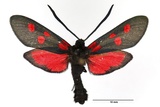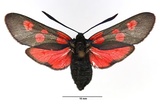Zygaena lonicerae (Scheven, 1777) Species
Last modified: Nov. 4, 2023, 4:55 p.m.
A very rare and local species in the southern part of Belgium.
Details
- Classification
- Family: Zygaenidae > Subfamily: Zygaeninae > Genus: Zygaena > Subgenus: Zygaena > Species: Zygaena lonicerae
- Vernacular names
- Valse vijfvlek-sint-jansvlinder (NL), Narrow-bordered Five-spot Burnet (EN), La Zygaena lonicerae, Zygène du chèvrefeuille, La Zygène des bois (FR), Hornklee Widderchen (DE)
- First mention in Belgium
- De Sélys-Longchamps E. 1837. Catalogue des Lépidoptères ou Papillons de la Belgique, précédé du tableau des Libellulines de ce pays. — — : 1–29. On page 23 (as Zygoena [sic] Lonicerae). view page
- Status
-
Native
Distribution
Imago
Wingspan 30–46 mm. The forewings usually show five crimson to vermilion spots and a black basic colour, with a strong bluish or blue-green reflection. The third spot is smaller than the fourth one and rarely emerged. Head, thorax and abdomen are black and moderately to strongly hairy. The antennae are long and slender and slightly clavate (club shaped) and tapered.
The apex of forewing more pointed and black terminal band on hindwing narrower.
The moth is very similar to Zygaena trifolii and is therefore often confused. Determination by genitalia examination required.
Egg
The eggs are pale yellow.
Caterpillar
Lenght 19–28 mm. The larvae are bluish green or pale yellow, with long pale hairs (setae) and a few rows of almost rectangular black spots.
Cocoon/pupa
The colour of the pupa varies from brown to black. Cocoon detached on the stems of grasses.
Bionomics
The larvae eat until late summer and early winter, and continue to develop in the following year. At the end of May the caterpillars are fully grown. The not fully grown caterpillars overwinter a second time. The caterpillars pupate in an elongated or spindle-shaped yellowish or white cocoon on grasses and other plants.
They are active during the day and visiting different flowers like Scabiosa, Knautia, Cirsium and Centaurea.
Flight periods
The adults fly from end of June towards August in one generation.
Observed on
- Host plant (species):
- Trifolium pratense, Trifolium repens, Trifolium montanum, Lathyrus pratensis, Lathyrus montanus, Onobrychis viciifolia, Lotus corniculatus, Lotus uliginosus and Vicia sylvatica
- Host plant (genera):
- Trifolium and Lathyrus
The larva lives on different species of Trifolium and Lathyrus.
Habitat
It prefers dry to mesophilic habitats, open forests, calcareous grassland and chalk downland.



